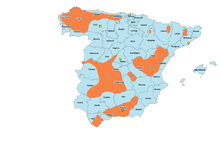You can help expand this article with text translated from the corresponding article in Spanish. (January 2020) Click [show] for important translation instructions.
|
This article includes a list of general references, but it lacks sufficient corresponding inline citations. (April 2019) |
| Spanish Maquis | |||||||
|---|---|---|---|---|---|---|---|
| Part of the aftermath of the Spanish Civil War, World War II, and the Cold War | |||||||
 Principal areas of Maquis activity within Spain (orange), 1939–1965. | |||||||
| |||||||
| Belligerents | |||||||
|
Supported by: (1939–1945) (1939–1943) (after 1953) |
Supported by: | ||||||
| Commanders and leaders | |||||||
|
|
among others… | ||||||
| Casualties and losses | |||||||
| ~1,000+ killed |
5,548 total 2,166 killed 3,382 captured or arrested[1] | ||||||
The Maquis ([ˈmaki(s)]; Basque: Maki; also spelled maqui)[2][3] were Spanish guerrillas who waged an irregular warfare against the Francoist dictatorship within Spain following the Republican defeat in the Spanish Civil War until the early 1960s, carrying out sabotage, robberies (to help fund guerrilla activity) and assassinations of alleged Francoists as well as contributing to the fight against Nazi Germany and the Vichy regime in France during World War II.[4] They also took part in occupations of the Spanish embassy in France.
The Maquis activity in Spain had its heyday towards 1946, after which the resistance fighters were heavily repressed during the Trienio del Terror (1947–1949), with instances of White Terror such as paseos, and applications of the Ley de fugas (extralegal executions based on the simulation of the escape of detainees) taking a heavy toll among the combatants and their supporters.[5] Following its decline, it fully disappeared in the 1960s.
- ^ "Armed resistance to Franco, 1939-1965 - Antonio Téllez". Libcom.org. Retrieved 1 April 2019.
- ^ López, Enrique Ávila (December 7, 2015). Modern Spain. ABC-CLIO. ISBN 9781610696012 – via Google Books.
- ^ Goodkind, Molly; Mitchell, Marcella Hayes and Amanda (October 26, 2015). Spanish Civil War and Its Memory, The. Edicions Universitat Barcelona. ISBN 9788447539277 – via Google Books.
- ^ Marco, Jorge: Guerrilleros and Neighbours in Arms: Identities and Cultures of the Anti-fascist Resistance in Spain. Brighton, Sussex Academic Press, 2016
- ^ Moreno Gómez, Francisco (2001). "Huidos, maquis y guerrilla: una década de rebeldía contra la dictadura" (PDF). Ayer (43): 131. ISSN 1134-2277.